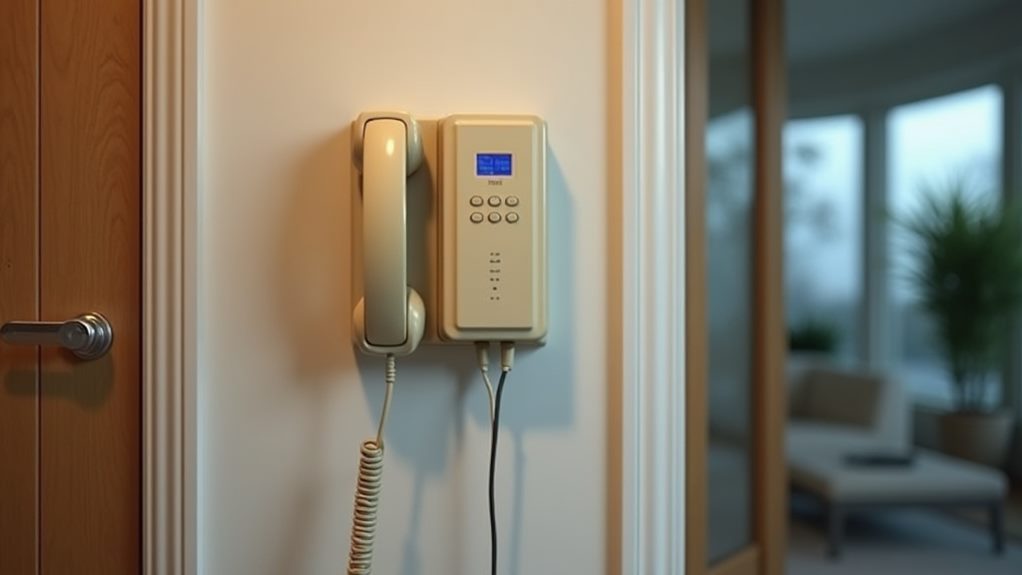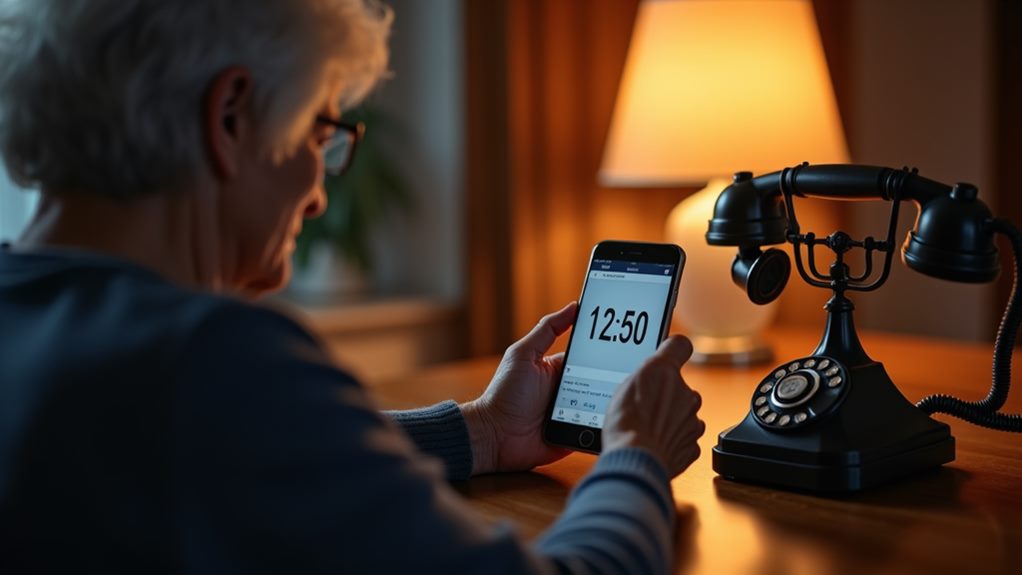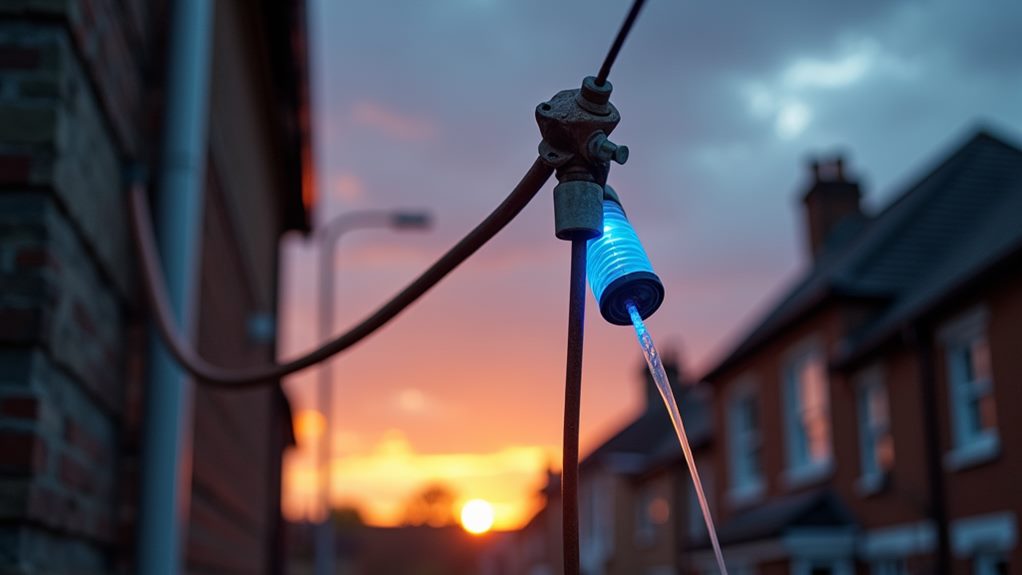BT isn't stopping landline service entirely, but you'll see a major shift from traditional copper-wire phones to Digital Voice technology by January 2027. This change means your landline will operate through your broadband connection using VoIP (Voice over Internet Protocol) instead of the old PSTN network. You'll keep your existing phone number and can usually use your current handset, though you'll need a reliable internet connection. The switch brings benefits like improved call quality and advanced features, but it also requires consideration for power outages and backup solutions. Understanding the full scope of this digital transformation will help you prepare effectively for the change.
The Digital Voice Switch Timeline

The Digital Voice Switch Timeline
Three key dates mark BT's Digital Voice switchover timeline, with the changeover beginning in earnest and concluding by January 2027. As BT offers various VoIP services, including Cloud Voice options for scalability, you'll need to prepare for this significant alteration as BT transitions from traditional landlines to Digital Voice technology across their entire network.
The timeline unfolds in three distinct phases. First, you'll see the initial rollout intensifying through 2024, as BT begins systematically migrating customers to the new digital platform.
Then, starting in Spring 2025, there's a vital focus on vulnerable customers, who'll receive priority attention and specialized support during their shift.
Finally, you'll need to complete your switch by the end of 2025, as the traditional Public Switched Telephone Network (PSTN) heads toward full decommissioning by January 2027.
During this transition, you'll maintain your existing phone number, and most of your current handsets will continue to work.
However, you'll need to adapt to mandatory area code dialing for all calls. Your provider will contact you directly with specific switch dates, ensuring you're fully informed about when you'll need to make the change to Digital Voice.
Understanding Digital Landline Technology
Digital landlines transform your voice into data packets that travel through your broadband connection, replacing the traditional copper wire system that carried analogue signals for decades.
This technology utilizes VoIP technology fundamentals to convert analog voice signals into digital data, enhancing call efficiency.
Your existing phone number and handset will continue to work with Digital Voice technology, but you'll need an internet connection and, in most cases, a special adapter to connect your phone to your router.
While traditional landlines operated independently of the internet and maintained service during power outages, Digital Voice requires both power and internet connectivity, though backup solutions are available to maintain service during disruptions.
How Digital Landlines Work
With modern technology evolving, traditional copper-wire telephones are giving way to Voice over Internet Protocol (VoIP) systems, marking a fundamental shift in how landlines operate. Your digital landline converts voice signals into data packets that travel through your Internet connection, enabling crystal-clear communication and advanced features you won't find in older systems.
This transformation is driven by the need for more efficient and scalable communication solutions, where VoIP technology allows users to enjoy call routing and added flexibility.
The core components of modern digital voice services include:
- Internet connectivity as the primary transmission medium
- VoIP technology for converting analog voice to digital signals
- Fiber-optic or broadband infrastructure replacing copper lines
- Backup power systems for continued service during outages
- Digital features like video calling and number portability
You'll find that your digital landline integrates seamlessly with your existing broadband connection, providing enhanced reliability and functionality.
When you make a call, your voice is instantly digitized and transmitted across the network, allowing for features that weren't possible with traditional systems.
While you'll need an Internet connection to use these services, backup systems guarantee you stay connected during power interruptions.
The technology's designed to maintain the familiar aspects of traditional landlines while bringing you the benefits of modern digital communication.
Digital Voice Vs Traditional
Understanding how Digital Voice compares to traditional landlines reveals significant technological and operational differences that impact your home communication setup.
Digital Voice operates through Voice over Internet Protocol (VoIP) technology, utilizing your internet connection rather than the aging PSTN infrastructure that traditional landlines rely on.
You'll notice several key advantages with Digital Voice compared to traditional landline service. The change brings you substantial cost reductions, particularly for international calls, where you can save up to 90% on calling rates.
Your existing phone number won't change during the shift, and you can continue using your current handset, making the switch seamless for your household.
The move to Digital Voice means you'll experience improved call quality through modern fiber-optic networks, surpassing the limitations of older copper-based systems.
While you'll need a broadband connection to use Digital Voice, the benefits include enhanced reliability and better sound clarity.
This technological leap guarantees you're part of a more advanced communication network that's built for the future, offering improved functionality while maintaining the familiar aspects of your home phone service.
Requirements For Home Phone Service

To maintain phone service in BT's Digital Voice changeover, you'll need an active broadband internet connection and a compatible phone handset that connects to your router.
Your existing phone number stays intact, but you must guarantee your internet setup meets BT's minimum requirements for voice calls, typically a speed of at least 0.5Mbps.
You'll also need to adapt to mandatory area code dialing for all calls, reflecting the technological shift from copper lines to internet-based telecommunications.
Essential Connection Components Needed
Switching to digital landline service requires several key components to guarantee reliable home phone connectivity. As part of the digital shift, you'll need a stable internet connection since your phone service will operate through VoIP technology. This modern system integrates seamlessly with your existing infrastructure while providing enhanced communication capabilities.
To make sure you're fully equipped for digital voice services, you'll need:
- A reliable broadband internet connection for VoIP functionality
- A compatible router or internet-enabled device
- Power supply for continuous operation
- Battery backup units (especially important if you're vulnerable to power cuts)
- Your existing handset (after checking compatibility)
Your digital phone service depends on electricity, unlike traditional analog lines. That's why it's vital to take into account battery backup units if you live in an area prone to power cuts.
Internet Setup For Calls
Building on these core components, proper internet setup stands at the heart of BT's Digital Voice service. You'll need a stable broadband connection that meets the minimum speed requirement of 1 Mbps to guarantee reliable call quality. This internet setup for calls transforms your traditional phone service into a modern VoIP system, allowing you to make and receive calls through your internet connection.
Your existing handsets will typically work with the new system, though you might need to adjust some settings during the changeover. Remember that you'll need to dial area codes for all calls once you've switched to Digital Voice, so it's worth updating your stored contacts accordingly.
Since the service relies on your internet connection, you should consider what happens during a power cut. While mobile phones can serve as backup, BT provides free battery backup units to vulnerable customers, safeguarding they maintain essential communication access during outages.
The setup process integrates seamlessly with your current broadband service, creating a unified communications system that connects you to both the digital and traditional telephone networks. This modernization guarantees you're part of the evolving telecommunications landscape while maintaining familiar calling features.
Power Outages and Backup Solutions
Power reliability stands as a vital consideration in BT's digital landline shift, as broadband-dependent phone systems can become inoperative during electrical outages.
You'll need to understand how this impacts your home communication setup and what backup solutions are available to keep you connected.
- Free battery backup units provided by BT for vulnerable customers
- Priority repair services guaranteeing quick response times for at-risk users
- Mobile network alternatives for maintaining communication during outages
- Backup power solutions to maintain broadband connectivity
- Emergency mobile phone options as a fallback communication method
If you're among BT's vulnerable customers, you'll receive priority access to backup solutions that keep your phone service running during power cuts.
BT's commitment to maintaining reliable communication means you won't be left without options.
You'll want to ascertain your home is equipped with appropriate backup power systems, particularly if you rely heavily on your phone service for emergency assistance.
While the digital change brings modern features, it's essential to maintain alternative communication methods.
Keep your mobile phone charged and ready as a backup option, and if you qualify as a vulnerable customer, take advantage of BT's free battery backup units to maintain your connectivity during outages.
Supporting Vulnerable Phone Users

Several million vulnerable phone users, including elderly customers and those with telecare devices, require specialized support during BT's change to Digital Voice services.
With approximately 2 million UK residents relying on telecare devices connected to traditional landlines, you'll find thorough assistance programs designed to guarantee your continued access to essential communication services.
If you're among BT's vulnerable customers, you'll receive tailored support starting in Spring 2025.
You'll benefit from priority repair services to minimize any disruption to your phone connection, ensuring you stay connected when you need it most.
For your safety during power outages, BT provides free battery backup units, which keep your phone service running even when the electricity fails.
The change to Digital Voice affects your existing landline setup, but you won't be left without support.
If you're using telecare devices or have specific accessibility needs, BT's commitment includes personalized assistance throughout the conversion period.
You'll receive guidance on adapting your current systems to work with the new digital infrastructure, ensuring you maintain reliable communication access as the 2025 completion deadline approaches.
Cost and Equipment Considerations
Moving beyond support services, the financial aspects of BT's Digital Voice rollout affect millions of UK households. The change brings several key considerations for your home telecommunications setup, with cost implications varying based on your current equipment and connectivity status.
Key aspects you'll need to evaluate for the Digital Voice switch:
- No additional charges when keeping your existing phone number
- Most current telephone handsets remain compatible with the new system
- Free battery backup units available for vulnerable customers
- Consistent pricing structure with your existing contract
- Required broadband connection for service functionality
Your primary financial focus centers on ensuring adequate internet connectivity, as Digital Voice operates through your broadband connection.
While BT maintains current contract pricing for Digital Voice services, you'll need to factor in reliable internet service for uninterrupted calling.
If you're using telecare devices, it's crucial to verify compatibility with your provider, as some equipment may require updates or replacement.
The change fundamentally transforms your traditional landline into a digital service, eliminating separate line rental while maintaining familiar equipment in most cases.
Scam Protection During Transition

As millions of UK households shift to Digital Voice, scammers are increasingly targeting customers unfamiliar with the new technology. With nearly 30 million households affected by this change, it's vital that you're equipped to protect yourself against fraudulent schemes during the digital landlines switchover.
You'll want to implement the STOP principle whenever you receive suspicious communications: Stop, Think, and Challenge any requests related to your phone service. This simple framework helps you maintain vigilance during this vulnerable period.
To strengthen your scam protection measures, you can access official resources, including BT's extensive PDF guide, which details common scam tactics and prevention strategies.
Stay connected to reliable information sources throughout the change. Both Ofcom's website and GOV.UK regularly update their platforms with essential security advisories and fraud prevention tips specific to the Digital Voice rollout.
You're part of a nationwide change, and it's important to remember that legitimate providers won't pressure you into making immediate decisions about your service. By staying informed and vigilant, you'll help protect yourself and your community from scammers who might try to exploit this technological shift.
Final Thoughts
The landline's analog sunset is approaching as BT shifts 29 million UK customers to digital voice by 2025. You'll need to prepare for this technological leap by ensuring your broadband connection and power backup solutions meet new requirements. While the switch mirrors the digital TV shift of 2012, it'll demand more attention to vulnerable users and security measures. Market data suggests initial equipment costs of £50-£200 per household during conversion.

